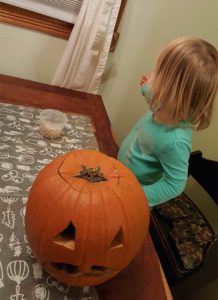 My granddaughter asked “what’s that?” as I was wiping up pumpkin mess. I looked up and saw her pointing to the wall and the round gray mimic cast by our big orange beauty. “That’s a shadow! Do you see how it moves as I slide this over? And if I turn the light off. . . it goes away! Isn’t that amazing? The light is what causes that shadow and the pumpkin is just blocking light on the wall. See, you can do the same thing with your hand: move your fingers and see how you can block the shine and change the shadow’s shape.” So, she got totally engaged with that exercise, and kept twinkling her fingers while I twinkled with thoughts.
My granddaughter asked “what’s that?” as I was wiping up pumpkin mess. I looked up and saw her pointing to the wall and the round gray mimic cast by our big orange beauty. “That’s a shadow! Do you see how it moves as I slide this over? And if I turn the light off. . . it goes away! Isn’t that amazing? The light is what causes that shadow and the pumpkin is just blocking light on the wall. See, you can do the same thing with your hand: move your fingers and see how you can block the shine and change the shadow’s shape.” So, she got totally engaged with that exercise, and kept twinkling her fingers while I twinkled with thoughts.
Shadows are signs, you see. They are faint things that point to something else more real. The Shadow doesn’t exist unless there is a real thing. It’s a signifier, then, that something else is near. Shadows are ephemeral markers that something substantive exists. A mystic I am reading said “all things are shadows, but Thou art substance. All things are quicksands but Thou art mountain.” Shadows point to something way more consequential, if we attend to them and investigate further.
But we don’t typically like facing any idea of this “Thou” character, the light caster, the shadow maker. We would rather stay hidden in our caves of shadows, borrowing from Plato’s parable. We may see the shadows on our walls but will firmly dismiss hints of more in a realm beyond our darkening walls. “The world bathed in the sunshine outside is off-limits and strictly dismissed as fiction.” Writes the Christian philosopher Os Guiness. We are moderns and post-moderns you see. We “know” better, no longer indulging fantasies that involve a God or any possibility of signs. We rather blindly dull-ly remain in cave-bound captivity.
A little girl noticed something interesting and asked “what is that?”